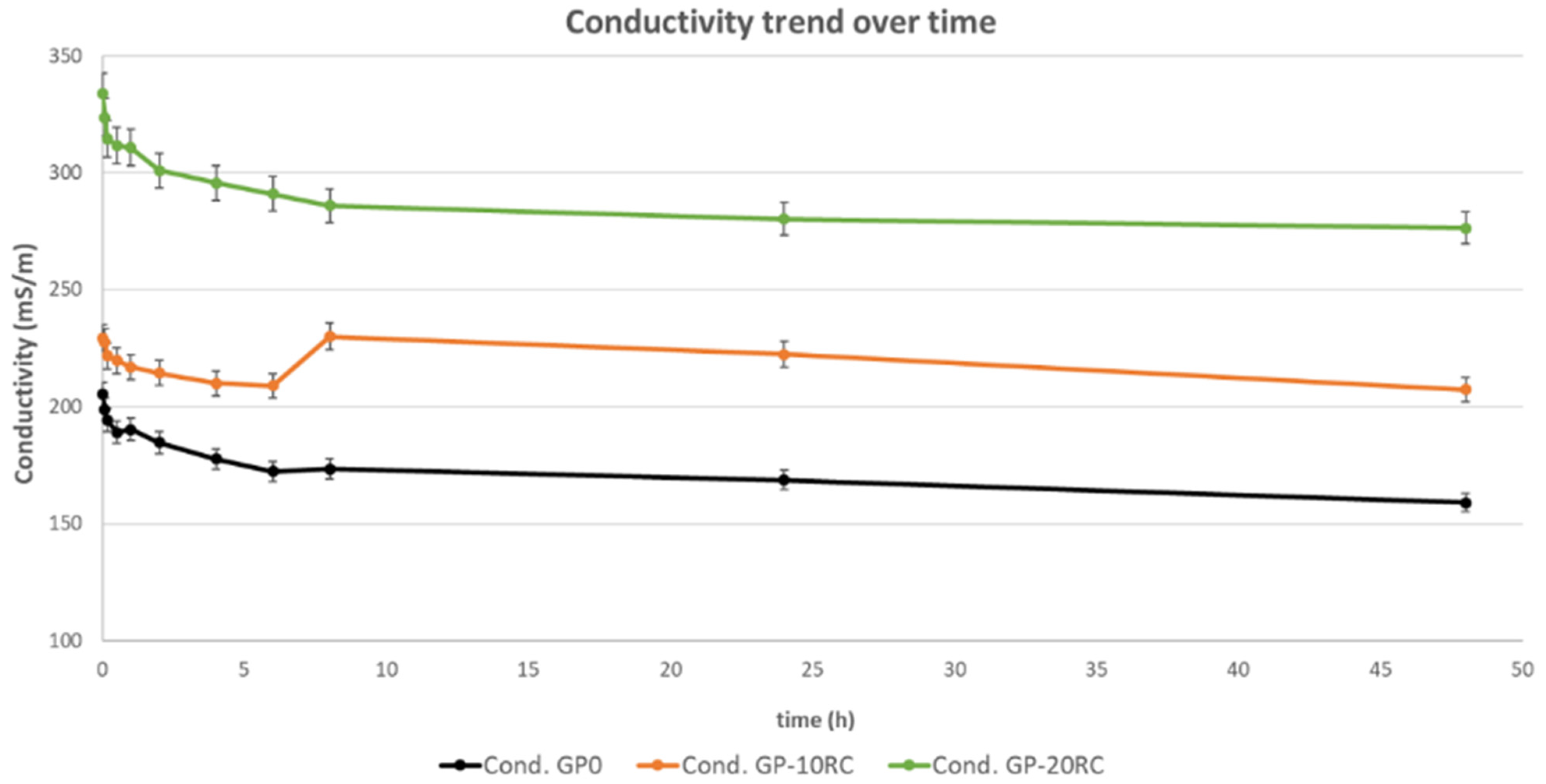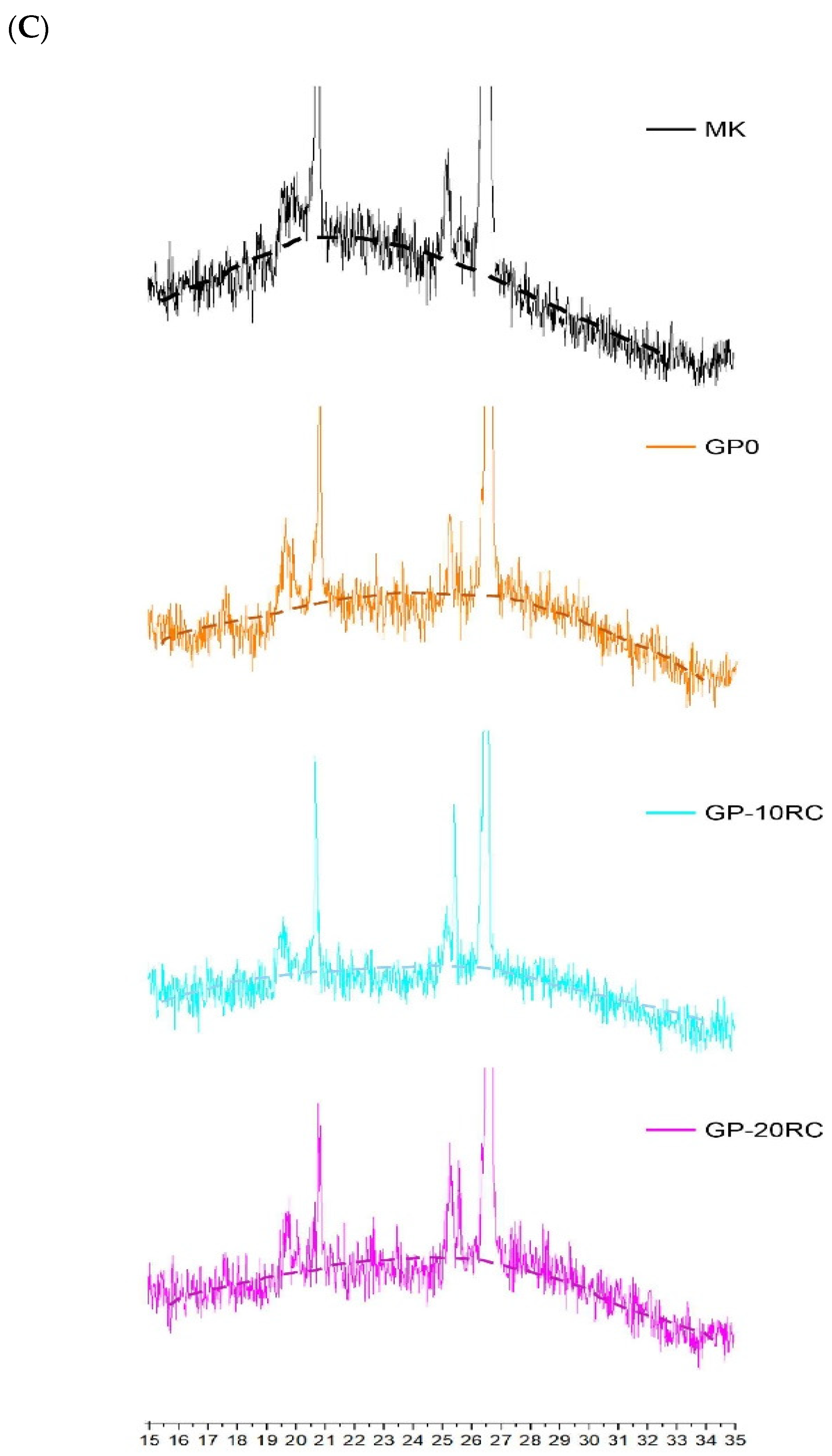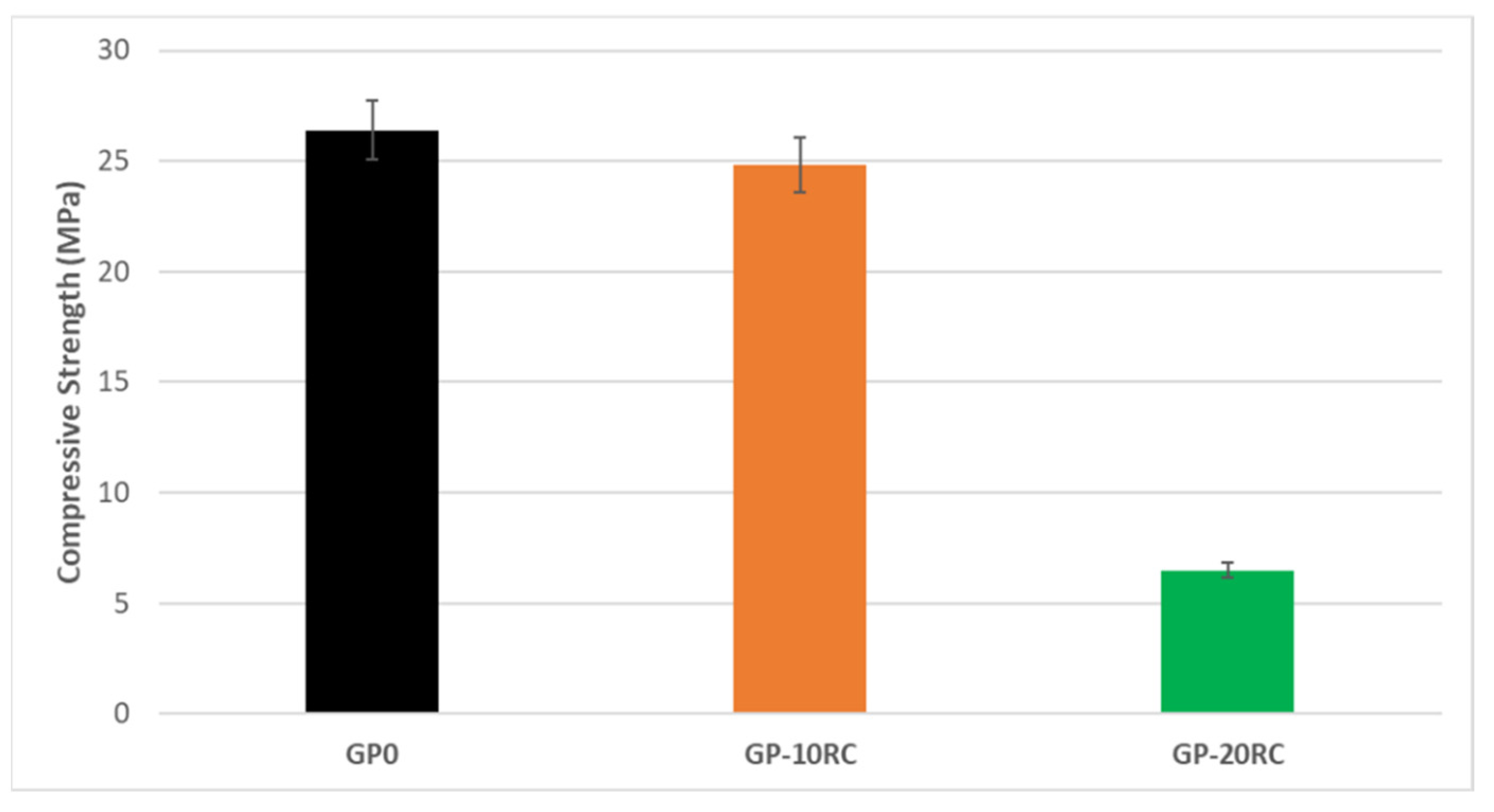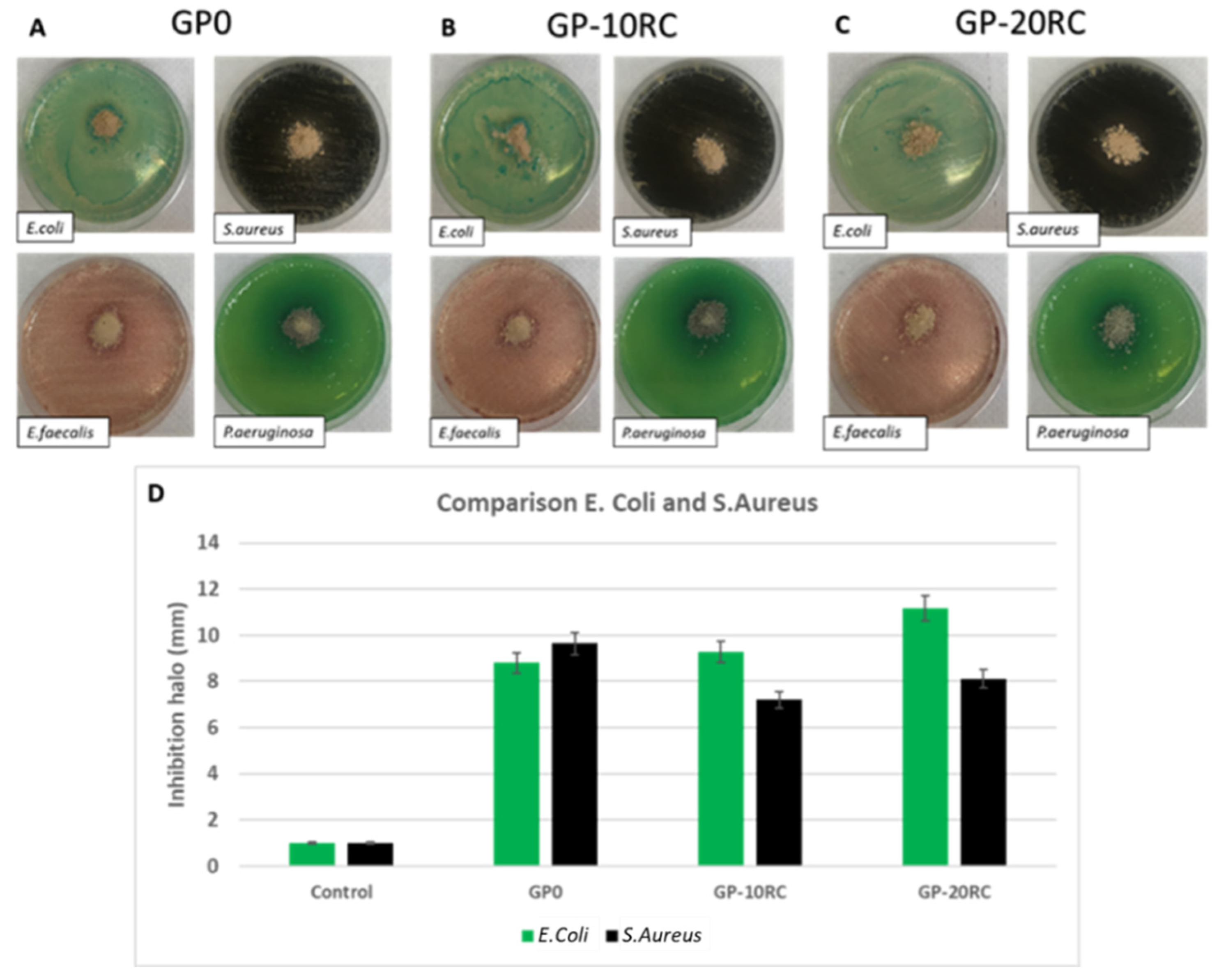Recycling of Waste Corundum Abrasive Powder in MK-Based Geopolymers
Abstract
:1. Introduction
- (1)
- (2)
- rice hush ash, bagasse ash, and other ashes from biomasses rich in silica to decrease curing time and increase mechanical properties [13];
- (3)
- (4)
- a combination of Al2O3 plus SiO2 sources in form of simple oxide mixture to increase density and thermal resistance [16];
- (5)
- ultra-fine slag to increase in strength characteristics and improve durability [17];
- (6)
- waste glass from containers and WEEE (Waste Electrical and Electronic Equipment) recycling to decrease shrinkage upon drying and toughness [18]; and
- (7)
- ceramic filler to improve dimensional stability and mechanical resistance after thermal exposure [19].
2. Materials and Methods
2.1. Materials
2.2. Preparation of Geopolymer Specimens
2.3. Geopolymers Characterization
2.3.1. Ionic Conductivity Measurements
2.3.2. Leaching Test
2.3.3. Microstructural Characterization
2.3.4. Mineralogical Composition
2.3.5. Mechanical Properties
2.3.6. Antibacterial Properties
3. Results
3.1. Ionic Conductivity
3.2. Leaching Test
3.3. Microstructural Characterization
3.4. Mineralogical Composition
3.5. Mechanical Properties
3.6. Antibacterial Properties
4. Discussion
5. Conclusions
- fast room temperature consolidation, since after 24 h in plastic mould they were demoulded without deformation;
- good chemical stability in air, as proved by the absence of efflorescence at the solid surface;
- good chemical stability in water, as indicated by the contained increase in the pH and ionic conductivity of the water after immersion;
- the insertion of RC slightly shift the ionic conductivity of water from that of the reference GP0 formulation:ionic conductivity increase from GP0 to GP10RC, and GP20RC;
- the leaching test results indicated that the release of the heavy metals is below law limits with exception of V, that is present in the starting MK and not in the RC;
- the principal process of reticulation has been evidenced by the FT-IR peaks analysis that proved that RC do not affect the regular MK’s geopolymerization process;
- mineralogical analysis did not show any novel crystalline phase formation, remaining the microstructure amorphous for the most fraction of the geopolymeric samples;
- when introducing RC in the formulations the mechanical performance reaches its maximum compression resistance value with 10% addition, indicating this content as the favoured one; and
- geopolymers added with RC do not show higher antibacterial properties with respect to GP0 even though some bacteria could receive a slight, yet measurable, negative impact on their growth when in contact with the tested materials.
Author Contributions
Funding
Institutional Review Board Statement
Informed Consent Statement
Data Availability Statement
Acknowledgments
Conflicts of Interest
References
- Hickel, J.; O’Neill, D.W.; Fanning, A.L.; Zoomkawala, H. National responsibility for ecological breakdown: A fair-shares assessment of resource use, 1970–2017. Lancet Planet. Health 2022, 6, e342–e349. [Google Scholar] [CrossRef]
- Thomark, C. Conservation of energy and natural resources by recycling building waste. Resour. Conserv. Recycl. 2001, 33, 113–130. [Google Scholar] [CrossRef]
- Davidovits, J. Geopolymers-inorganic polymeric new materials. J. Therm. Anal. 1991, 37, 1633–1656. [Google Scholar] [CrossRef]
- Elimbi, A.; Tchakoute, H.K.; Njopwouo, D. Effects of calcination temperature of kaolinite clays on the properties of geopolymer cements. Constr. Build. Mater. 2011, 25, 2805–2812. [Google Scholar] [CrossRef]
- Van Deventer, J.S.J.; Provis, J.; Duxson, P. Technical and commercial progress in the adoption of geopolymer cement. Miner. Eng. 2012, 29, 89–104. [Google Scholar] [CrossRef]
- Palomo, A.; Krivenko, P.; Garcia-Lodeiro, I.; Kavalerova, E.; Maltseva, O.; Fernández-Jiménez, A. A review on alkaline activation: New analytical perspectives. Mater. Constr. 2014, 64, 22. [Google Scholar] [CrossRef] [Green Version]
- Provis, J.L.; Van Deventer, J.S.J. Geopolymers: Structure, Processing, Properties and Industrial Applications; Woodhead Publishing: Cambridge, UK, 2009. [Google Scholar]
- Pacheco-Torgal, F.; Chindaprasirt, P.; Ozbakkaloglu, T. Handbook of Advances in Alkali-Activated Concrete; Woodhead Publishing: Cambridge, UK, 2022. [Google Scholar]
- Zhang, Y.; Wei, S.; Zongjin, L. Composition design and microstructural characterization of calcined kaolin-based geopolymer cement. Appl. Clay Sci. 2010, 47, 271–275. [Google Scholar]
- Kohout, J.; Koutnik, P. Effect of filler type on the thermo-mechanical properties of metakaolinite-based geopolymer composites. Materials 2020, 13, 2395. [Google Scholar] [CrossRef]
- Xiang, J.; Liu, L.; Cui, X.; He, Y.; Zheng, G.; Shi, C. Effect of Fuller-fine sand on rheological, drying shrinkage, and microstructural properties of me-takaolin-based geopolymer grouting materials. Cem. Concr. Compos. 2019, 104, 103381. [Google Scholar] [CrossRef]
- Perna, I.; Novotna, M.; Supova, M.; Hanzlicek, T. Beach Sand: Alternative Filler in Metakaolin-Based Geopolymers. J. Mater. Civ. Eng. 2021, 33, 04021017. [Google Scholar] [CrossRef]
- Tippayasam, C.; Keawpapasson, P.; Thavorniti, P.; Panyathanmaporn, T.; Leonelli, C.; Chaysuwan, D. Effect of Thai Kaolin on properties of agricultural ash blended geopolymers. Constr. Build. Mater. 2014, 53, 455–459. [Google Scholar] [CrossRef]
- Tchakouté, H.K.; Kamseu, E.; Banenzoué, C.; Rüscher, C.H.; Andreola, F.; Tchamo, C.C.L.; Leonelli, C. Role of γ-Al2O3 on the mechanical and microstructural properties of metakaolin-based geopolymer cements. J. Sol-Gel Sci. Technol. 2018, 86, 305–315. [Google Scholar] [CrossRef]
- Yasin, S.; Ahlatcı, H. Thermal investigation of fine alumina powder reinforced Na-metakaolin-based geopolymer binder for refractory applications. J. Aust. Ceram. Soc. 2019, 55, 587–593. [Google Scholar] [CrossRef]
- Kamseu, E.; Rizzuti, A.; Leonelli, C.; Perera, D. Enhanced thermal stability in K2O-metakaolin-based geopolymer concretes by Al2O3 and SiO2 fillers addition. J. Mater. Sci. 2010, 45, 1715–1724. [Google Scholar] [CrossRef]
- Parveen, P.; Mehta, A.; Saloni, S. Effect of ultra-fine slag on mechanical and permeability properties of Metakaolin-based sustainable geopolymer concrete. Adv. Concr. Constr. 2019, 7, 231–239. [Google Scholar]
- Dal Poggetto, G.; Catauro, M.; Crescente, G.; Leonelli, C. Efficient addition of waste glass in MK-based geopolymers: Microstructure, antibacterial and cytotoxicity investigation. Polymers 2021, 13, 1493. [Google Scholar] [CrossRef]
- Kovarik, T.; Rieger, D.; Kadlec, J.; Krenek, T.; Kullova, L.; Pola, M.; Belsky, P.F.; Riha, J. Thermomechanical properties of particle-reinforced geopolymer composite with various aggregate gradation of fine ceramic filler. Constr Build. Mater. 2017, 143, 599–606. [Google Scholar] [CrossRef]
- Riahi, S.; Nemati, A.; Khodabandeh, A.R.; Baghshahi, S. Investigation of interfacial and mechanical properties of alumina-coated steel fiber reinforced geopolymer composites. Constr. Build. Mater. 2021, 288, 123118. [Google Scholar] [CrossRef]
- Rattanasak, U.; Chindaprasirt, P. Influence of NaOH solution on the synthesis of fly ash geopolymer. Miner. Eng. 2009, 22, 1073–1078. [Google Scholar] [CrossRef]
- Škvára, F.; Šmilauer, V.; Hlaváček, P.; Kopecký, L.; Cílová, Z. A weak alkali bond in (N, K)–A–S–H gels: Evidence from leaching and modelling. Ceram.—Silikáty 2012, 56, 374–382. [Google Scholar]
- Ponzoni, C.; Lancellotti, I.; Barbieri, L.; Spinella, A.; Saladino, M.L.; Chillura Martino, D.; Caponetti, E.; Armetta, F.; Leonelli, C. Chromium liquid waste inertization in an inorganic alkali activated matrix: Leaching and NMR multinuclear approach. J. Hazard. Mater. 2015, 286, 474–483. [Google Scholar] [CrossRef] [PubMed]
- Moutinho, S.; Costa, C.; Andrejkovicova, S.; Mariz, L.; Sequeira, C.; Terroso, D.; Rocha, F.; Velosa, A. Assessment of properties of metakaolin-based geopolymers applied in the conservation of tile facades. Constr. Build. Mater. 2020, 259, 119759. [Google Scholar] [CrossRef]
- FEPA-Standard 43-2:2017; Grains of Fused Aluminium Oxide, Silicon Carbide and Other Abrasive Materials for Coated Abrasives Microgrits P 240 to P 5000. Available online: https://www.normadoc.com/english/standards/european-standards/fepa.html (accessed on 2 May 2022).
- Dal Poggetto, G.; D’Angelo, A.; Blanco, I.; Piccolella, S.; Leonelli, C.; Catauro, M. FT-IR Study, thermal analysis, and evaluation of the antibacterial activity of MK-geopolymer mortar using glass waste as fine aggregate. Polymers 2021, 13, 2970. [Google Scholar] [CrossRef] [PubMed]
- Catauro, M.; Dal Poggetto, G.; Pacifico, S.; Andreola, F.; Lancellotti, I.; Barbieri, L. A new system of sustainable silico-aluminous and silicate materials for cultivation purpose within sustainable buildings: Chemical-physical, antibacterial and cytotoxicity properties. Appl. Sci. 2022, 12, 434. [Google Scholar] [CrossRef]
- Priya, G.K.; Padmaja, P.; Warrier, K.G.K.; Damodaran, A.D.; Aruldhas, G. Dehydroxilation and high temperature phase formation in sol-gel boehmite characterized by Fourier transform infrared spectroscopy. J. Mater. Sci. Lett. 1997, 16, 1584–1587. [Google Scholar] [CrossRef]
- Panias, D.; Giannopoulou, I.P.; Perraki, T. Effect of synthesis parameters on the mechanical properties of fly ash-based geopolymers. Colloids Surf. A Physicochem. Eng. Asp. 2007, 301, 246–254. [Google Scholar] [CrossRef]
- Makreski, P.; Jovanovski, G.; Kaitner, B.; Stafilov, T.; Boev, B.; Cibrev, D. Minerals from Macedonia. X. Separation and identification of some oxide minerals by FT IR spectroscopy, AAS, AES-ICP and powder XRD. Neues Jahrb. Mineralogie Abh. 2004, 180, 215–243. [Google Scholar] [CrossRef]
- Joo Hyun, P.; Dong Joon, M.; Hyo Seok, S. FT-IR spectroscopic study on structure of CaO-SiO2 and CaO-SiO2-CaF2 slags. ISIJ Int. 2002, 42, 344–351. [Google Scholar]
- Ruiz-Santaquiteria, C.; Fernandez-Jimenez, A.; Palomo, A. Quantitative determination of reactive SiO2 and Al2O3 in aluminosilicate materials. In Proceedings of the XIII International Congress on the Chemistry of Cement, Madrid, Spain, 3–8 July 2011. [Google Scholar]
- Temuujin, J.; Minjigmaa, A.; Rickard, W.; Lee, M.; Williams, I.; Riessen, A.V. Preparation of metakaolin based geopolymer coatings on metal substrates as thermal barriers. Appl. Clay Sci. 2009, 46, 265–270. [Google Scholar] [CrossRef]
- Nakajo, K.; Komori, R.; Ishikawa, S.; Ueno, T.; Suzuki, Y.; Iwami, Y.; Takahashi, N. Resistance to acidic and alkaline environments in the endodontic pathogen Enterococcus faecalis. Oral Microbiol. Immunol. 2006, 21, 283–288. [Google Scholar] [CrossRef]








| Al2O3 | SiO2 | CaO | SO3 | Fe2O3 | TiO2 |
|---|---|---|---|---|---|
| 91.73–92.00% | 2.49–3.58% | 2.41–2.81% | 1.00–1.30% | 0.59–1.06% | 0.42–0.61% |
Publisher’s Note: MDPI stays neutral with regard to jurisdictional claims in published maps and institutional affiliations. |
© 2022 by the authors. Licensee MDPI, Basel, Switzerland. This article is an open access article distributed under the terms and conditions of the Creative Commons Attribution (CC BY) license (https://creativecommons.org/licenses/by/4.0/).
Share and Cite
Dal Poggetto, G.; D’Angelo, A.; Catauro, M.; Barbieri, L.; Leonelli, C. Recycling of Waste Corundum Abrasive Powder in MK-Based Geopolymers. Polymers 2022, 14, 2173. https://doi.org/10.3390/polym14112173
Dal Poggetto G, D’Angelo A, Catauro M, Barbieri L, Leonelli C. Recycling of Waste Corundum Abrasive Powder in MK-Based Geopolymers. Polymers. 2022; 14(11):2173. https://doi.org/10.3390/polym14112173
Chicago/Turabian StyleDal Poggetto, Giovanni, Antonio D’Angelo, Michelina Catauro, Luisa Barbieri, and Cristina Leonelli. 2022. "Recycling of Waste Corundum Abrasive Powder in MK-Based Geopolymers" Polymers 14, no. 11: 2173. https://doi.org/10.3390/polym14112173






